
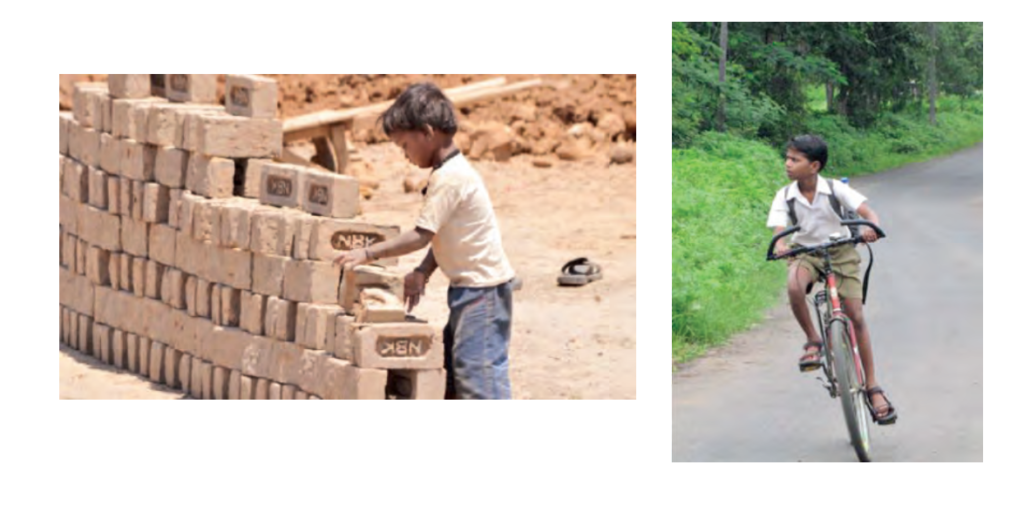
(a) Main difference between the two images ……………………………………………………………………………………………………………………………………………………………….
(b) Change required ……………………………………………………………………………………………………………………………………………………………….
(c) Your contribution as a student to help and make a difference to needy children ………………………………………………………………………………………………………………………………………………………………..
(a) Main difference between the two images.
Ans. One child is working and the other is going to school
(b) Change required.
Ans. The child working should also be going to school.
(c) Your contribution as a student to help and make a difference to needy children.
Ans. My contribution would be not to purchase goods involving child labour and encouraging helpers at home to educate their children.
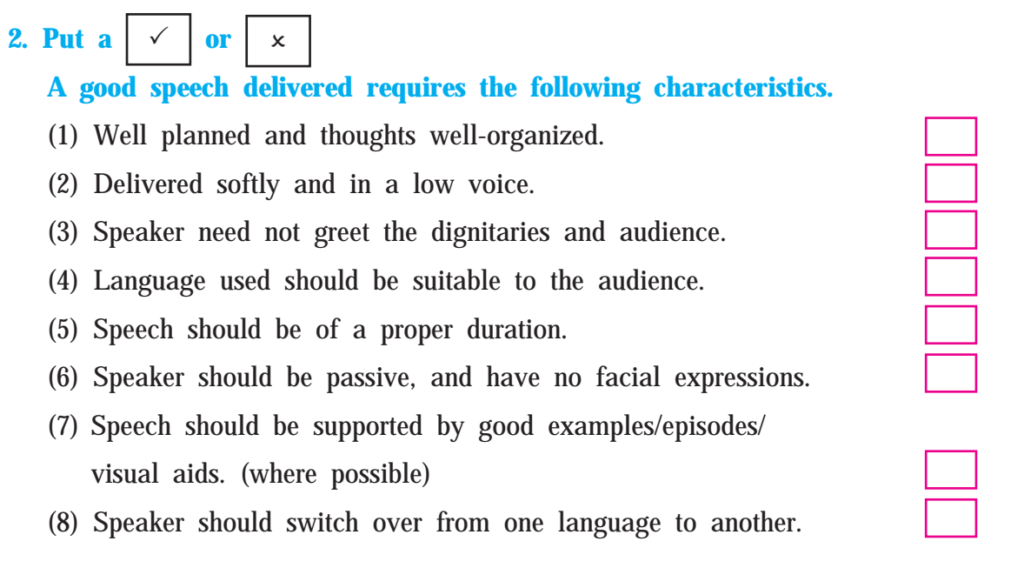
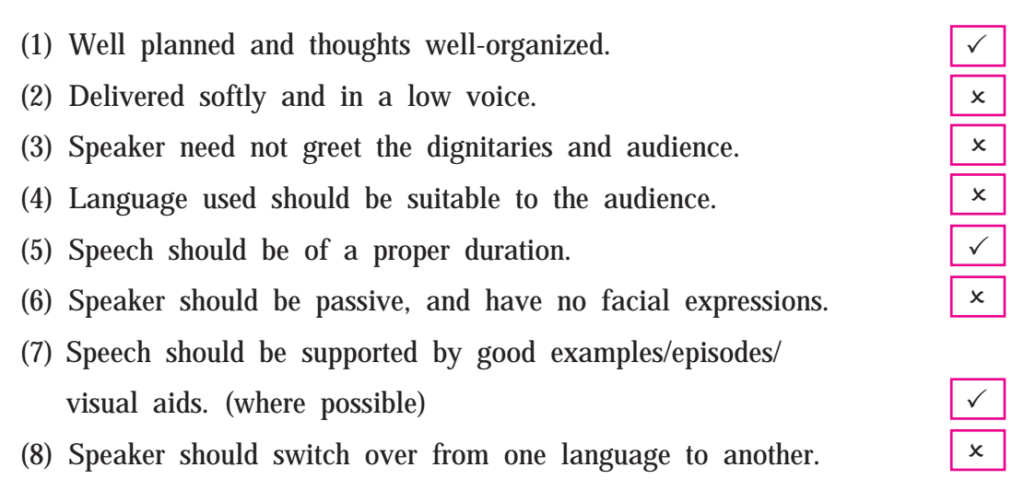
3. Read the expressions and insert them in the proper columns. Put the proper expression numbers in the right column.
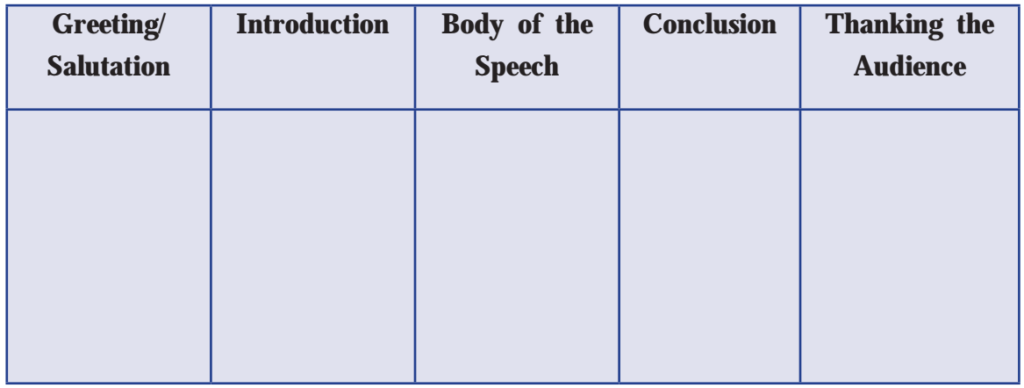
Expressions
(1) Imagine ! After ten years, what will happen?
(2) Let me begin, today, by sharing my own experience.
(3) Honourable Chief Guest ………………… , eminent dignitaries, ladies and gentlemen.
(4) I don’t understand why we accept this issue so passively.
(5) I am Adarsh Birajdar, (designation) standing before you …………………
(6) A renowned personality (name) says “ ………………… ”
(7) Good morning, to one and all present today.
(8) I express my deep gratitude to the organisers of this event/function …………………
(9) Let me give you an example…………………
(10) Thank you all for a patient listening and your interest in my talk.
(11) You must have noticed that…………………
(12) Before I conclude, I would like you to think over the fact that…………………
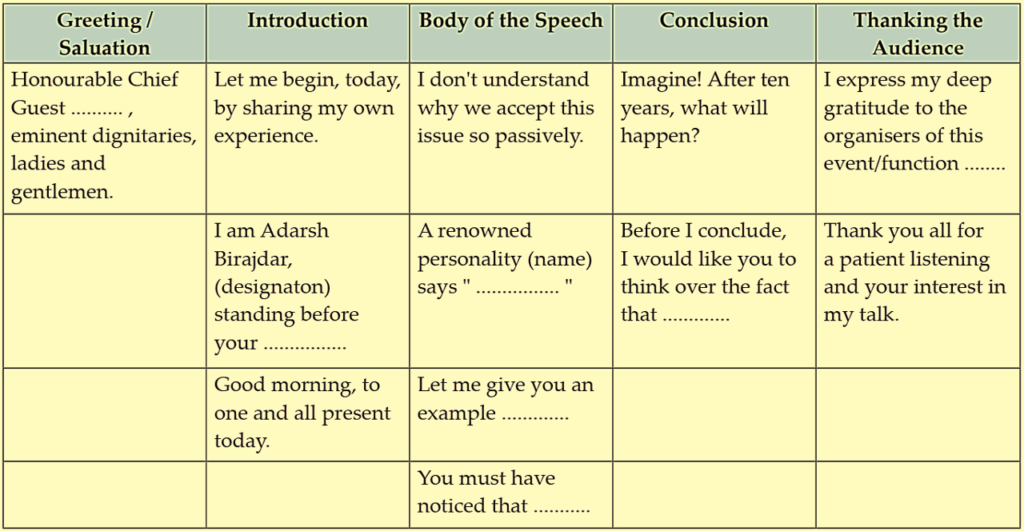
4. With the help of your teacher and classmates make a list of as many Indian Nobel Laureates as you can. (You can use Internet or school library.)

… FACTUAL QUESTIONS …
What does Satyarthi refuse to accept?
Ans. Satyarthi refused to accept that the world is so poor, when just one week of global military expenditure can bring all the children to classrooms. He refused to accept that all the laws and constitutions, police and judges are unable to protect our children. Also he refused to accept that the shackles of slavery can ever be stronger than the quest for freedom.
What is the only aim in life for Kailash Satyarthi ?
Ans. Kailash Sathyarthi’s only aim in life is to ensure that every child is free to be a child, free to grow, develop, eat, sleep, see daylight, laugh, cry, play, learn, go to school and dream.
What did millions of individuals demand eighteen years ago?
Ans. Eighteen years ago, millions of individuals demanded a law to abolish child labour.
Why does the eight year old girl’s question shake Mr.Satyarthi ?
Ans. The eight year old girl’s question shakes Mr. Satyarthi because it questions our inaction.
What matters according to Satyarthi?
Ans. According to Satyarthi, every single minute, every single child and every single childhood matters.
What does Satyarthi challenge?
Ans. Satyarthi challenges the passivity and pessimism surrounding our children and the culture of silence, passivity and nuetrality.
What was the response of the boy’s father ? What was Satyarthi’s reaction to it ?
Ans. Shri Satyarthi was angry listening to the cobbler’s answer as he had resigned to fate and his situation and believed that things cannot change. Somewhere the society is responsible for making the poor believe that education is the right of the privileged. This according to me, must have made Shri Satyarthi angry.
What was Mr. Satyarthi’s vision as a child?
Ans. As a child, Mr. Satyarthis had a vision of a tomorrow – a vision that the cobbler boy would be sitting with him in his classroom.
What is your vision of tomorrow ?
Ans. A vision helps to go beyond what we think is possible and helps us realise where we are heading. My vision is to help Mumbai become a zero waste city.
What rights should every child have, in our times?
Ans. Every child should have a right to life, right to freedom, right to health, right to education, right to safety, right to dignity, right to equality and right to peace.
What does Mr. Satyarthi request the listeners ?
Ans. Mr Satyarthi requests the listeners to put their hands close to their hearts close their eyes and feel and listen to the child inside them.
According to Mr.Satyarthi, who are calling for us?
Ans. According to Mr. Satyarthi, thousands of Mahatma Gandhis, Nelson Mandelas and Martin Luther Kings are calling on us.

1. Name the following.
(a) The persons to whom Kailash Satyarthi gives the highest credit of his honour –
(b) The greatest personalities from the land of Buddha –
(c) So called daughters of Kailash Satyarthi –
(d) The foreign activists of equal rights, mentioned in the speech –
Ans.
(a) Kaalu Kermar, Dhoom Das and Adarsh Kishore from India. and Iqbal Masih from Pakistan.
(b) Guru nanak and Mahatma Gandhi
(c) Malala two girls named Kayanat and Shazia
(d) Nelson Mandela and Martin Luther king.
2. Mention the social issues highlighted by Kailash Satyarthi in his speech. One social issue is given for you.
(a) Child labour
(b) ……………………………
(c) ……………………………
(d) ……………………………
(e) ……………………………
(f) ……………………………
Ans.
(a) Child labour
(b) Illiteracy
(c) Slavery
(d) Child marriage
(e) Sexual abuse
(f) trafficking
3. Complete the following diagram/chart.
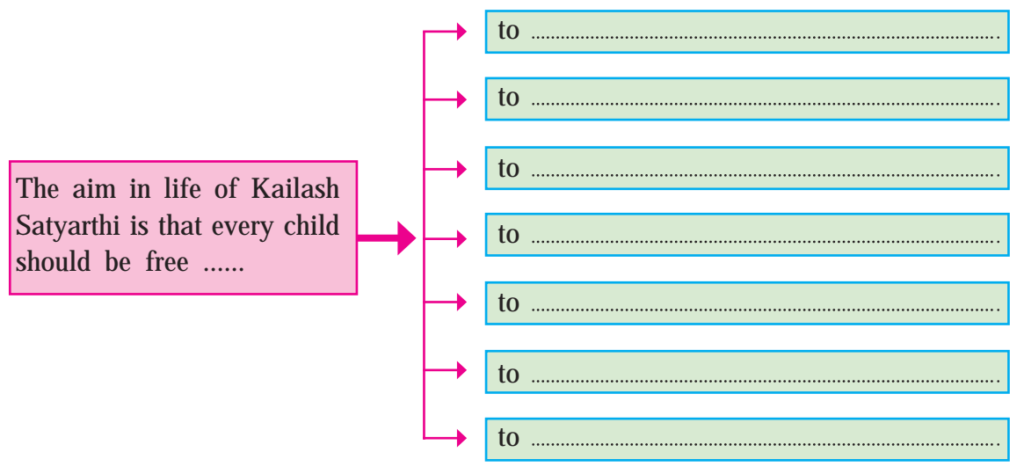
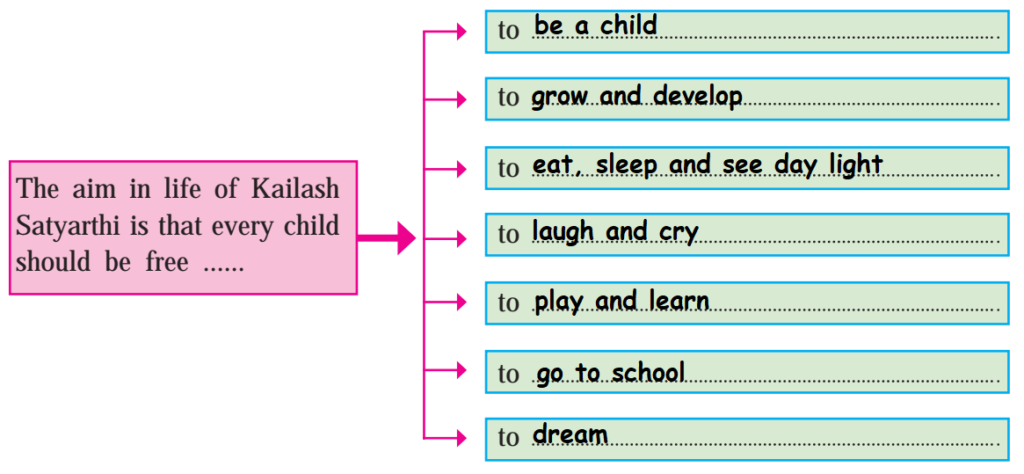

Ans.
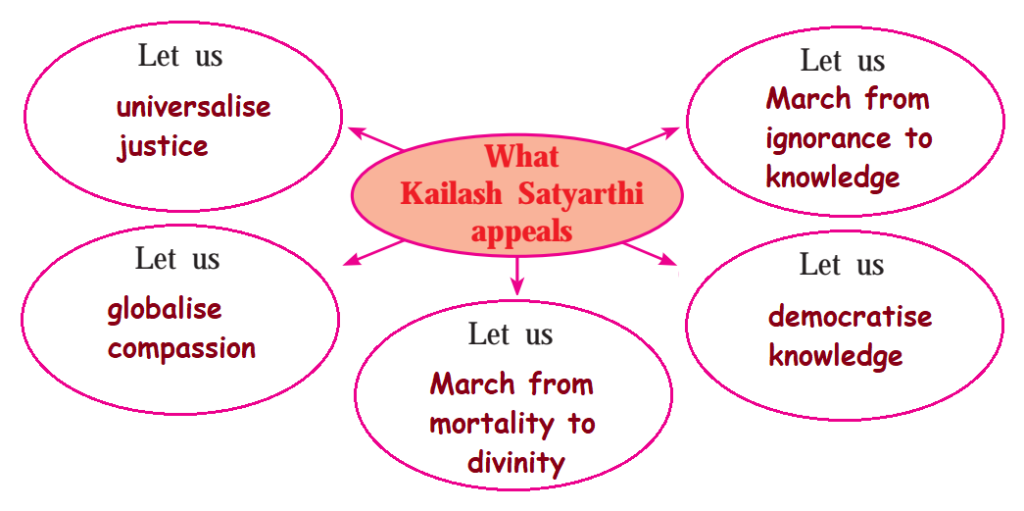
5. Think and give your own response.
(a) How can education help the deprived children and child labourers?
(b) Name any other social activist who has worked/is working earnestly for child-welfare. Write about his/her activities.
(c) What message does the little bird’s story of the forest fire convey to us? Explain.
(d) Besides the political freedom that our nation enjoys, what other freedom should it strive for? Say why.
(e) What is your impression of the acceptance speech given by Kailash Satyarthi, when he received the Nobel Prize? Write in 3 to 4 sentences.
Ans.
(a) How can education help the deprived children and child labourers?
Ans. Education can help the deprived children and child laboures gain the required knowledge and skill that will help them to get better jobs when they grow up and improve their condition.
(b) Name any other social activist who has worked/ is working earnestly for child-welfare. Write about his/her activities.
Ans. Nina P. Nayak is a social worker and child rights activist from Dakshina kannada. She has dedicated her life to the promotion and protection of child rights. Her works include :
(a) Recognition of child rights.
(b) Policy formulation for child’s rights.
(c) Implementation of these policies of the Government of India.
(d) She has been a driving force in the implementation of ‘Juvenile Justice Act’ and the ‘Protection of Children Against Sexual offences Act.
(c) What message does the little bird story of the forest fire convey to us? Explain.
Ans. The story of the little bird and the forest fire conveys to us the message that each one of us needs to contribute our bit towards improving the condition of child labourers. We must remember that it takes only one person to start a revolution. If all of us take responsibility and do our bit, nothing is impossible.
(d) Besides the political freedom that our nation enjoys, what other freedom should it strive for? Say why.
Ans. Besides political freedom that our nation enjoys, it should strive for social freedom where equality is the guiding principle. In remote corners of India, even today people are exploited on the basis of caste, creed and gender. Besides this, we should also strive for freedom of thought to make the people of our country more progressive in their thoughts so that they abandon all superstitions and adopt scientific attitude.
(e) What is your impression of the acceptance speech given by Kailash Satyarathi, when he received the Nobel Prize? Write in 3 to 4 sentences.
Ans. The acceptance speech by Kailash Satyarthi given by him during his acceptance of the Nobel Prize gives us a glimpse of the work carried out by him and other child welfare activists for which he has been awarded the Nobel Prize. Besides discussing challenges related to children’s rights, it also inspires us to do our bit towards improving the plight of children around us Hence the speech is not just factual but also successfully inspiring.
6. Choose the correct option and write in front of the given word, to convey the exact meaning.
(a) divinity :
(i) goodness (ii) godliness (iii) god-fearing
(b) extremist :
(i) militant (ii) robber (iii) spy
(c) culminate :
(i) destroy (ii) succeed (iii) rise to a peak
(d) exploitation :
(i) explosion (ii) misuse (iii) employment
(e) mortality :
(i) death (ii) virtues (iii) starvation
(f) dignity :
(i) self-pride (ii) self-support (iii) self-esteem
Ans.
(a) divinity :
(i) goodness (ii) godliness (iii) god-fearing
(b) extremist :
(i) militant (ii) robber (iii) spy
(c) culminate :
(i) destroy (ii) succeed (iii) rise to a peak
(d) exploitation :
(i) explosion (ii) misuse (iii) employment
(e) mortality :
(i) death (ii) virtues (iii) starvation
(f) dignity :
(i) self-pride (ii) self-support (iii) self-esteem
7. Pick out from the lesson the-
(A) Noun forms of the following words-
(a) dignified ………………………….
(b) pacify ………………………….
(c) pursue ………………………….
(d) ignore ………………………….
(e) poor ………………………….
(f) divine ………………………….
(B) Verb forms of-
(a) democracy ………………………….
(b) global ………………………….
(c) hindrance ………………………….
(d) resolution ………………………….
(e) liberty ………………………….
(f) service ………………………….
(A)
(a) dignity (b) passivity (c) pursuit (d) ignorance (e) poverty (f) divinity
(B)
(a) democratise (b) globalise (c) hinder (d) resolve (e) liberate (f) serve
8. (A) Use the following words as a noun as well as a verb and make meaningful sentences with each set, in your notebook.
march, honour, credit, stitch
March – (i) The MCC students march with heads held high. (verb)
(ii) He participated in the protest march (noun)
Honour – (i) We honour soldiers for their sacrifice and bravery (verb)
(ii) He is an honour to his nation. (noun)
Credit – (i) Credit the amount in my bank account. (verb)
(ii) I give the girl the credit for her bravery. (noun)
Stitch – (i) Stitch me a gown that no lady in the town has. (verb)
(ii) She decorated the scarf with a fancy stitch. (noun)
(B) Write minimum 4 hidden words of more than 4 letters from – intergovernmental
Ans. (i) government (ii) rental / mental (iii) talent (iv) intern / internal
(C) Make meaningful sentences by using the following phrases, in your notebook.
(a) in the pursuit of
(b) be afraid of
(c) give up
Ans. (a) in the pursuit of– He left for the Himalayas, renouncing everything, in the pursuit of peace.
(b) be afraid of – One who seeks knowledge is not afraid of asking questions.
(c) give up – It is easy to give up in the face of difficulty; what is difficult is to stay on.
(D) Pick from the lesson the antonyms of
ignorance × ………………..
immortality × ………………..
deny × ………………..
violence × ………………..
well- known × ………………..
slavery × ………………..
Ans. (i) Knowledge (ii) mortality (iii) accept (iv) peace (v) unknown (vi) freedom
9. (A) What will you do in the following situations ?
(a) If you see a child working in a restaurant .……………………………………………………………
(b) If you find a child working at a construction site……………………………………………………………...
(c) If you find a child working at a brickwork site……………………………………………………………...
(d) If you come across a beggar child……………………………………………………………..
(a) If you see a child working in a restaurant.
Ans. If I see a child working in a restaurant. I would talk to him and his parents and encourage him to go to school.
(b) If you find a child working on a construction site.
Ans. I would speak to the contractors and convince them not to employ the child and talk to his parents. I would also contact an NGO to rescue the child.
(c) If you find a child working on a brickwork site.
Ans. If I find a child working on a brickwork site, I would immediately talk to his employer. If he would not listen, I would report it to an NGO working for children’s rights.
(d) If you come across a beggar child.
Ans. If I come across a beggar child, I would immediately report it to NGO’s such as ‘Save the Children’ that works for the welfare of street children. I would also inform on child helpline –………
(B) Write any 2 efforts that you can make to enrol deprived children/ out of school children into a school. One is given for you.
(a) I will persuade parents of such children to send them to school.
(b) ………………………………………………………………….
(c) ………………………………………………………………….
Ans.
(a) I will persuade parents of such children to send them to school.
(b) I will persuade my parents to fund the education of atleast 2 children.
(c) I will find out NGO’s that work for such children.
10.(A) Types of Sentence
A sentence is a group of words that expresses a complete idea. Sentences can be classified in various ways. The following is a classification of sentences.
(i) Assertive sentence (Statement) : A sentence that makes a statement or assertion is a sentence.
For example, ‘There are many villages in India.’
(ii) Interrogative sentence : It is a sentence that asks a question. It is of two sub-types.
Yes/no interrogative sentence :
It generally begins with a helping verb or an auxiliary verb and can be answered by saying ‘Yes’ or ‘No’. For example, ‘Are you coming with us?’
Wh-interrogative sentence : It begins with a wh- word, such as ‘who’ and ‘why’ and cannot be answered by saying ‘yes’ or ‘no’. For
example, ‘What is the time?’
(iii) Imperative sentence : It expresses commands, requests etc. It generally begins with a verb. For example, ‘Open your books’.
(iv) Exclamatory sentence : It expresses a strong feeling.
For example, ‘How wonderful the river looks !’ ‘What a shame !’
(B) Say whether the following sentences are Assertive (Statements), Imperative (Commands, Requests, etc.), Interrogative (Questions) or Exclamatory (Exclamations).
(1) The Mantra carries a prayer …………………….
(2) Is the world so poor? …………………….
(3) Kill not your children because of poverty ……………………..
(4) Let’s walk together ……………………..
(5) What can one person do? …………………….
(6) We have made progress ……………………..
(7) How utterly we have failed our children! …………………….
(8) What a big challenge it is! …………………….
(i) Statement
(ii) Yes / No interrogative sentence
(iii) Imperative sentence
(iv) Imperative Sentence
(v) Wh-interrogative Sentence
(vi) Statement
(vii) Exclamatory Sentence
(viii) Exclamatory Sentence
(C) Rewrite the following sentences as Assertive (statements).
(1) Why didn’t you come earlier? ………………….
(2) How frightened their eyes look! ………………….
(3) How angry it makes me! ………………….
(4) Should I accept such shackles of slavery? ………………….
(i) Why didn’t you come earlier?
Ans. You should have come earlier.
(ii) How frightened their eyes look!
Ans. Their eyes look extremely frightened.
(iii) How angry it makes me!
Ans. It makes me very angry.
(iv) Should I accept such shackles of slavery?
Ans. I will not accept such shackles of slavery.
(v) What can one person do?
Ans. One person cannot do anything.
11. (A) Observe the following underlined phrases. Here ‘have/has’ are followed by the past participle form of the verb. This construction indicates the
present perfect tense. Find more such sentences from the text.
(1) We have made progress in the last couple of decades.
(2) We have prevented millions of child deaths.
(3) It has happened.
(4) …………………………………….
(5) …………………………………….
(4) That’s why I have kept an empty chain as a reminder.
(5) I have come here only to share the voice and dreams of our children.
(B) In the following sentences the underlined words are called infinitives. Find such examples from the speech and underline the infinitives.
(1) Every child is free to grow.
(2) I refuse to accept that all the laws and constitutions, police and judges are unable to protect our children.
(3) ………………………………………………………………………………………………
(4) ………………………………………………………………………………………………
(5) ………………………………………………………………………………………………
(3) I am unable to do that.
(4) One day. I gathered courage to ask the boy’s father.
(5) I want you to see and feel this today inside you.
(C) Complete the following sentences with the help of the sentence given below.
(a) The biggest challenge knocking on the doors of human kind is fear and intolerance.
(i) No other challenge knocking …………………………………………………………………. as big as …………………………………………………………………………….
(ii) Fear and intolerance are bigger ……………………………………………………………………………………..
(b) The Nobel Prize is one of the greatest honours in the world.
(i) Very few honours ………………………………………………………………….
(ii) The Nobel Prize is greater than ………………………………………………………………….
(a) The biggest challenge knocking on the doors of human kind is fear and intolerance.
(i) No other challenge knocking on the door of human kind is as big as fear and intolerance.
(ii) Fear and intolerance are bigger than any other challenges on the doors of human kind.
(ii) The Nobel Prize is one of the greatest honours in the world.
(a) Very few honours in the world are as great as the Nobel Prize.
(b) The Nobel Prize is greater than many other honours in the world.
12. (A) Match the sentences given in part ‘A’ with the sentences given in part ‘B’. Note the differences in structure.

Ans. (1 – c), (2 – a) , (3 – b)
(B) You might have observed that – The sentences in Part A are in the passive voice while the sentences in Part B are in the active voice. Now change the following sentences into the passive voice.
1. We can do it ……………………………………………………………….
2. Her angry question still shakes me ………………………………………………………………..
3. Governments must make child-friendly policies ………………………………………………………………..
4. His answer made me angry ………………………………………………………………..
(1) We can do it .
Ans. It can be done by us.
(2) Her angry question still shakes me.
Ans. I am still shaken by her angry question.
(3) Governments must make child-friendly policies.
Ans. Child-friendly policies must be made by governments.
(4) His answer made me angry.
Ans. I was made angry by his answer / I was angry with his answer.
13. Imagine your school invites Malala to preside over ‘Children’s Day’ celebration programme. Draft a welcome speech for this guest of honour. Gather information about her from Internet or your school library. While drafting a speech the following points should be kept in mind.
(1) Greeting and salutation
(2) Self introduction and introduction of the topic
(3) A catchy thought/piece of news/short episode, to start with
(4) Body of the speech supported with related examples and episodes
(5) Conclusion
Honourable Chief Guest Nobel Laureate. Miss Malala Yousafzai, Respected Principal, teachers and my dear friends, good morning and a very warm welcome. It is a matter of singular pride for me to extend a warm welcome to our guest of honour, Nobel laureate Miss Malala Yousafzai. She is not just a youth icon but an inspiration for many a women whose dreams have been shattered by baseless social taboos.
Our honourable Chief Guest, who is an activist for female education has been working for human rights especially education of women and children in her native Swat valley in Northeast Pakistan. Children have the right to choose a life of their own. They should be allowed to grow and develop and educate themselves. Today children are suffering from evils such as child labour, infant mortality, sexual abuse and trafficking. Hence it is only apt to have such a personality amongst us who can throw light on these challenges faced by children and share the experiences.
It is indeed a privilege for us to have you here with us, Miss Malala. Once again, I welcome you to the Children’s Day celebration of our school and request you to talk to the young minds of today and responsible citizens of tomorrow.
Thank you.